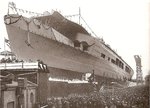Ramirezzz
Senior Airman
There are two other accounts of what may have been the fate of the Graf Zeppelin.
One is that she struck a mine left over from WW II and sank; the other is that she foundered in a storm as she was being towed to Leningrad.
Wonder what really happened
TO
She was definately sunk during the target practice - I have a very detailed account of how the exercise was executed, unfortunately, in russian only. I'm to lazy to translate it by myself, so try with an automatic translator
"Ликвидацию АВ «Graf Zeppelin» (*) предполагалось провести с максимальным военно-научным и практическим эффектом. Для этой цели приказом Главнокомандующего ВМС адмирала И.С. Юмашева №0029 от 17 мая 1947 г. была создана специальная комиссия под председательством вице-адмирала Ю.Ф. Ралля, в задачу которой входило потопление АВ с проведением испытаний воздействия на него авиационных бомб, артснарядов и торпед в так называемом «статическом» (подрыв заранее размещенных боеприпасов) и «динамическом» (фактические стрельбы и бомбометание) вариантах (разработка и подготовка программы испытаний также поручалась этой комиссии; кроме АВ, участь «подопытных кроликов» ожидала «карманный линкор» «Lutzow» и 13 ПЛ). Предполагалось, что на АВ сначала будут подорваны заранее заложенные авиабомбы и артснаряды различных калибров, затем он будет подвергнут бомбометанию с самолетов, расстрелу из орудий главного калибра крейсеров и, наконец, завершат дело «лихие» торпедные атаки надводных кораблей. Планировался также и подрыв мин на различных глубинах и удалениях. В промежутках между вариантами указанного сценария группы военных ученых должны были производить замеры, расчеты и проверки элементов корабля с минимальными действиями по восстановлению его живучести (например, запуск насосов для откачки воды)."
[...]
После первой серии взрывов была проведена авиационная бомбардировка АВ самолетами. Для выполнения этой задачи выделялись 39 экипажей 12-го Гвардейского авиаполка 8-й минно-торпедной авиадивизии и 25 самолетов Пе-2 — все имевшиеся исправные самолеты полка. Экипажи более современных самолетов Ту-2 не назначались, так как в течение 1946 и 1947 гг. они имели незначительную тренировку (понятное дело: война закончилась, можно и слегка «расслабиться». Однако как это все же напоминает июнь 1941 г.! — прим. авт.). К моменту выполнения задания во всех ВВС 4-го ВМФ вместо потребного количества в 156 авиабомб П-50 имелось только сто. Поэтому с учетом выполнения условий бомбометания и наличия боезапаса в ударе по АВ смогли принять участие только 24 экипажа Пе-2. Две девятки самолетов бомбили по сигналу ведущего в звене, а часть Пе-2 атаковали цель индивидуально. Удары обеспечивали два самолета типа «Каталина», один из которых, находясь над целью, наводил на нее ударную группу, а второй работал в поисковоспасательном варианте. Кроме того — неслыханная на войне роскошь! — управление ударными группами осуществлялось еще и с «Волынца», а на палубе «жертвы» был нарисован белый крест 20 на 20 м с шириной полос пять м.
Первая атакующая группа нанесла удар с высоты 2070 м и сбросила 28 авиабомб, вторая — примерно с той же высоты, сбросив 36, и третья (индивидуальное бомбометание) «разгрузилась» 24 бомбами. Три самолета вынуждены были сбросить бомбы в море аварийно. Результат бомбометания по почти неподвижному, беззащитному и совсем не маленькому кораблю оказался «впечатляющим»: из ста бомб в цель попали только шесть (!), причем обнаружить в палубе удалось лишь пять попаданий. Летчики же настаивали на одиннадцати, считая, что часть бомб попала в уже разрушенные предыдущими подрывами места. Так или иначе, но бомбардировка АВ с точки зрения живучести ничего не дала: бомбы П-50 оказались слишком маломощными и не наносили существенных повреждений, кроме вмятин в палубе глубиной 5-10 см. Правда, одна из бомб сделала пробоину в буле ПрБ диаметром около 1 м. Для боевой подготовки «сталинских соколов» атаки «Цеппелина» слишком полигонными и, видимо, мало поучительными: противовоздушной обороны, понятно, не осуществлялось, самолет наведения беспрепятственно «разгуливал» над целью, высота бомбометания соответствовала зоне плотного зенитного огня. Летчики (судя по воинским званиям — молодежь, не нюхавшая пороху) жаловались на плохую видимость разрывов и падений бомб. Смеем заключить, что данное «мероприятие» можно назвать боевой подготовкой лишь с известной долей воображения.
[...]
Taken from the military historical magazine "Typhoon", 3/1997






